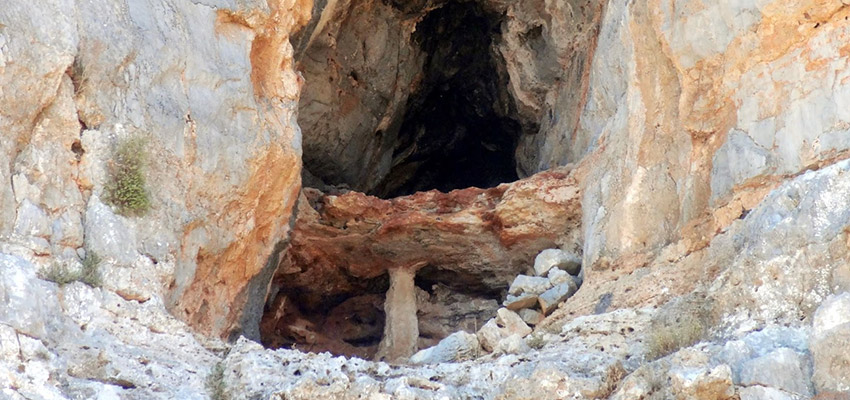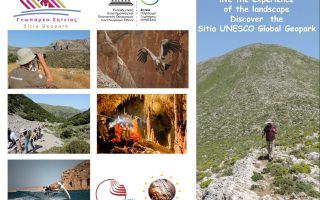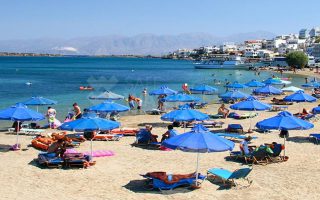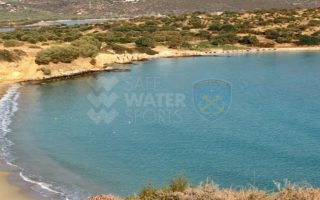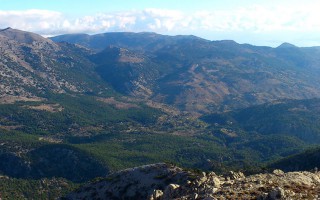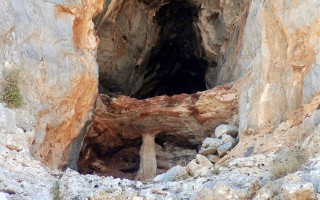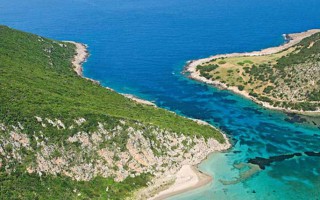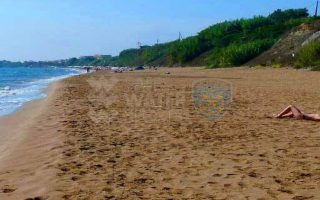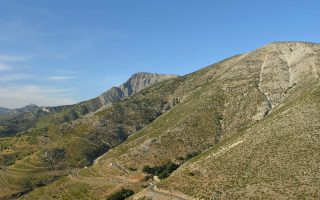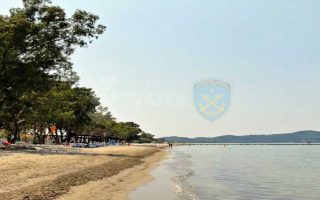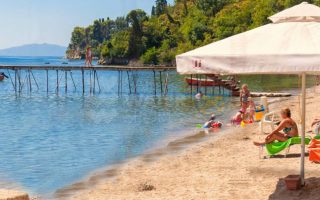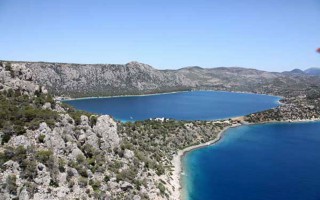It lies to the North-Northeast of Kato Zakros. We arrive at the cave either after a one-hour walk from Kato Zakros or from the beach of the same settlement by engine-vessel (20-25 minutes) and after that, we follow a tiresome ascending route (15 minutes walk). The elevation at the entrance attains 105 metres. Stones consist of limestones from the upper Cretaceous and of dolomites from the Triassic period. A little more west of the cave there is an elevation called Traostalos (elevation: 515 metres).
Pelekita (“hewn” in English) is the name by which the whole area is known. It comes from the quarry lying underneath the cave, near the seashore, where people used to extract hewn stones from the Meocene marly limestone deposits that exist there. Another name of the cave is Sikias Spilios (“Cave of the Fig Tree), due to the big fig tree that exists on the right side of the entrance under the cave, from where the view to the sea is breathtaking. Pelekita Cave is one of the biggest in Crete. Its total length attains 310 metres.
It has large chambers up to 45 metres in width and quite high. Corridors of a total length of 700 m approximately can be exploited. The cave takes up an area of 500 square metres approx. but if its inclinations are taken into account, the area is much more bigger. The first time it was roughly mapped and studied was by El. Platakis on 11th August 1963. A full mapping of the cave was conducted end of November 1969by members of the Greek Speleological Society led by I. Ioannou.
The entrance to the cave is large (11,5 in width, 6 metres in height). After that, the first chamber opens up (22 metres in length, 20 metres in width and 7 metres in height). Its floor is sloping with many rocks and low, artifical walls. To the left, there is an expansion that leads to a narrow passageway (0,2 metres), which later attains 6 metres. Here, we come across artificial walls, too.
After the first chamber, a passageway (14,5 metres in width and 2,30-7 metres in height) leads to the second chamber, which is big and very spectacular (65 metres in length, 45 metres in width and 15 metres in height) with sloping floor and big rocks that have fallen off the ceiling. On the rocks, there are small stalagmites.
At the beginning and on the right of the chamber there are majestic pillars and spectacular stalagmites, one of which has leaned over the rock touching it with its tip. A little further from the centre of the chamber, there is a nice platform with stalagmites, from which the view to all directions is quite impressive. The ceiling looks resembles a beautiful vault. On the right of the platform near the walls of the chamber there is a 15 metres deep pithole. On the left of the platform, the descent is very steep.
There, on a solid rock the geological decor is marvellous, forming cascades. The floor inclination continues to be steep. At the depths of the chamber there is a passageway, which attains 6 metres. From there begins a spectacular corridor, which is 10 metres in length and 4 metres in width, leading to another chamber with stalagmites (20 metres long, 17 metres wide and 8 metres high). Here, we are in a depth of 43 metres from the entrance of the cave.
At the end of the chamber we come across a 7,5 metre wide 5 metre high passageway. If we go down the passageway, we come across a third chamber with a floor that is sloping up to 35 metres and then it becomes ascending for 65 metres. As soon as the visitor enters the chamber, they become impressed with its size, with the majestic beauty of the natural decor and with the absolute calmness that evokes strong emotions. Its length is 100 metres, its width is 40 metres and its height exceeds 15 metres. Huge pillars and bulky stalgmites elevate from the floor, their height exceeding 10 metres. At the base, their diameter attains 3 metres.
All those make up a breathtakinly beautiful, majestic whole. Also in that chamber there is a big balcony, from where the visitor enjoys the glorious spectacle. The ascending part of the floor makes it very difficult to walk on, it is almost entirely covered with big rocks, very slippery and we need to climb up on many occasions. The chamber ends up in a passageway 9,5 m in width and approx. 5 metres high with many rocks scattered on the floor. The floor becomes sloping and leads us directly to the fourth chamber, which is 60 metres in length, 10-22 metres in width and 5 metres in height. The last part of that chamber presents a rich natural decor made of white pillars and beautiful stalagmites.
At the edge of the chamber, there is a cluster of small pillars and between them there is a narrow passageway, 1,2 metres in width. From there, we enter the last chamber of the cave (33 metres in length, 6 metres in width and 0,5-2 metres in height). On its right, a small corridor is formed and if we follow it, after 8 metres we come across a junction of another two very narrow corridors. Near the end of the chamber there is a small pond (5,5 * 1,2 metres) with water up to 1 metre deep.
After the pond, the floor is ascending ending up to a very narrow passage (0,30 m in width). Maybe there is more to it, however access is impossible. Here, we are in a depth of 51 metres from the entrance of the cave (vertically). This is the deepest part of the floor. Visitors must not go further than the pond or enter the corridor with the junctions. It is very dangerous and unsafe, since the floor (even near the pond) collapses when someone passes. Moreover, mud and other materials fall of the ceiling that may easily obstruct the exit.
The cave is a bed of an underground river, which is no dried up with the exception of the pond. From all parts of the ceiling small and also very big rocks have fallen off. The Cave Pelekita has been characterized as a cave of international tourist interest. The entire area with its magnificent cave, the Minoan palace of Zakros, the peak sanctuary of Traostalos, the Gorge of the Dead and the wonderful beach make up a whole of great significance for tourism.
Source: www.incrediblecrete.gr

